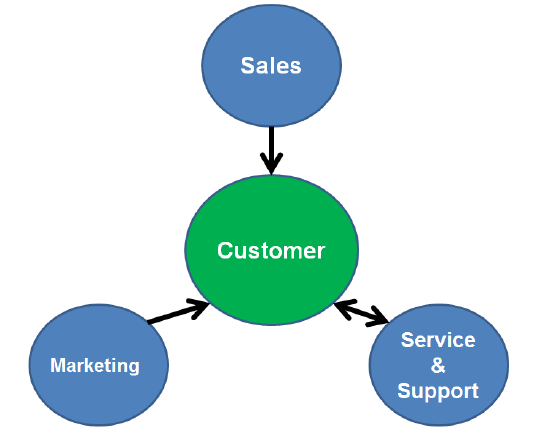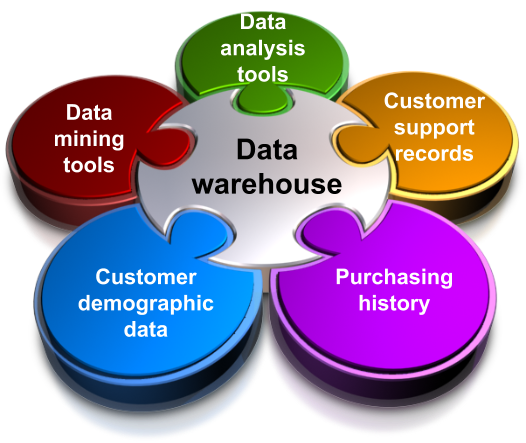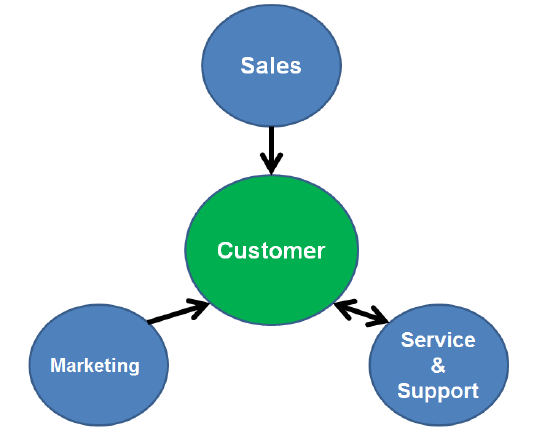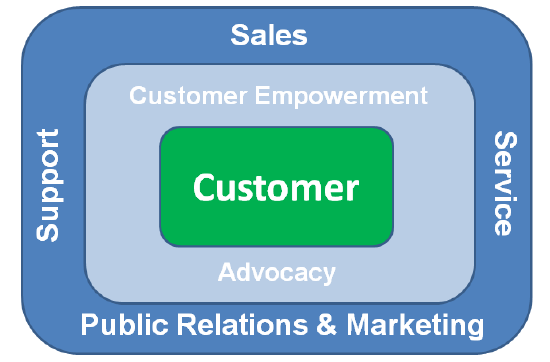5.1.3: CRM, Data Warehouses and Data Mining
- Page ID
- 10123
Learning Objectives
- Define what is meant by the term customer relationship management (CRM).
- Explain how data warehouses and data mining tools are used to perform CRM.
- Identify the potential impact of CRM on a company's business.
- Explain some of the trends in SCRM and changes that must be implemented.
Example \(\PageIndex{1}\)
A man walks into a convenience store to pick up some diapers, at his wife’s request. While he’s there, he just happens to pick up a six-pack of soda as well. Meanwhile, back at the convenience store headquarters, a data analyst poring through data in a data warehouse sees this and recognizes that this pairing is emerging as a pattern.
Opportunity? You bet. The data analyst makes two recommendations to her marketing department. First, move the diapers and the soda closer together. Second, place similar items that men in this age group might also be inclined to purchase in between the diapers and the soda. Welcome to the world of customer relationship management, or CRM.
This module will explain and define CRM. It will provide some examples of how it can be used, describe what makes it work and who is using it, and discuss whether it has been as successful as many had hoped.
Traditional CRM
Customer relationship management (CRM) is a strategy used by companies to better manage customer relationships. CRM also goes by the name of relationship marketing or customer management. The definition of CRM is very broad because it includes many facets of business-to-customer relationships.

Robust CRM systems are supported by software suites that help with the management of all the data acquired and used by the system. But the following might be considered the primary focus of any CRM system:
- providing a company's marketing department with information needed to identify and target the company's best customers, design effective marketing campaigns, and provide the sales team with quality leads
- optimizing the information shared among departments which results in an increased number of sales and new accounts, better management of existing accounts, and supporting the use of the latest communication devices (for example, allowing orders to be made over mobile phones)
- improving customer satisfaction by supporting the development of individualized relationships with customers; might also include providing the highest level of service to the most profitable customers
- obtaining and sharing with employees the information and processes necessary for them to effectively build relationships with their customers through understanding and identifying the customer's needs (CRM, 2006).
In summary, the primary applications that are supported by a CRM are customer:
- acquisition—obtaining new customers
- retention—retaining current customers
- loyalty—developing customer loyalty to the company/product
- profitability—increasing company profits by serving the customer
- service—addressing customer inquiries and resolving issues
learn by doing
In each of the following scenarios, identify which application of CRM is the primary focus.
Your credit card company awards points for its use—points that you can apply later to other purchases.
Targeted e-mail messages from Company XYZ about a new product are sent to women who have purchased a similar or related item from an online auction site, Company ABC.
You chat with a service representative at Company MOP to ask questions about your bill.
The airline you recently flew with asks you to complete a survey about the service you received.
Reset this Activity

Relationships among CRM, Data Warehouses, and Data Mining
The example cited in the introduction is one facet of CRM—data mining customers' purchasing patterns. Data mining is the process of looking at the data stored in a company's database to determine if statistically relevant trends exist. By identifying these trends and patterns, companies can develop strategies to better serve their customers and at the same time increase their sales.
Another example of CRM might be the evaluation of data purchased from a company that specializes in collecting demographic data on purchasers, including such data as location, age, gender, ethnicity, home ownership, employment status, and income level, to determine which individuals might have a requirement for the company’s product or services.
CRM can improve services and products in other ways as well. For instance, if an organization offers a call center that provides customer support, tracking the kind of support that is provided most frequently might lead to solutions that could prevent the problems from happening in the first place.
How It Works
Almost all CRM applications involve using a large relational database, sometimes referred to as a data warehouse. This is where the raw data about customers, products, transactions, demographics, and other information is stored. Typically, the data warehouse gets its information in real time, or nearly so, from systems used to conduct transactions between the company and the customer—point of sale (POS) systems, e-commerce web applications, inventory management systems, and others.
Using complex statistical analysis software programs known as data mining tools, data analysts are able to query the data warehouse in a multitude of ways. For instance, an analyst might ask the data mining tool to retrieve from the database all purchases made during the week of June 15 in which two specific products were purchased together in stores in their East Coast region. Then, once the records are returned, the analyst would ask the tool to show only those purchases in which a statistically relevant correlation between the two items existed.
Sound fascinating? That is only the beginning. Consider this: Why not design the data mining tool to run specific queries such as this one on all data, once a day, and send an e-mail to the analyst if anything interesting turns up? In other words, why not build "triggers" into the system that alert the analyst to anything that might be considered an anomaly, good or bad? Why not have the data mining tool do all the work?
By now, you have probably determined that sophisticated CRM data mining tools do just that.
did I get this \(\PageIndex{1}\)
Which of the following is the collection of data related to customer age, gender, location, income level, and so on?
True or false? When you sign on to an online store where you have shopped before, you are presented with a recommended list of items to purchase this time. The list appears to be tied to items you recently purchased. This is an example of data mining.
True or false? You are signing into your university’s single sign-on page. When you click on the ID box and insert the first letter of your ID, a list of potential IDs pops up from which you may choose the ID you want to use. This is an example of data mining.
Reset this Activity
CRM Is Big Business
There are real business benefits associated with improving customer relationships and offering great customer service. Research shows that companies that make customer experience a priority generate higher profits than their competitors. It is more cost effective to retain current customers than to attract new ones. So establishing and maintaining a good relationship with customers is critical to the financial bottom line.
What are major benefits for a company that uses CRM to improve relationships with its customers?
-
With CRM software, a company can track how long current customers have been with the company, how often they purchase from or use the company's services, and other key information. Rewarding customer loyalty does more than simply make customers feel good about the company; it can actually improve the company's financial picture (What is CRM?, n.d.). Think credit cards, frequent flyer programs, special offers for loyal customers, and other rewards programs.
-
It’s widely accepted that customers and prospective customers judge companies based on how well the company handles customer issues and complaints. CRM can facilitate the handling of customer problems because CRM systems allow for a more rapid response to queries and concerns by forwarding the query to the right department. And members of each department have access to all the relevant information, enabling them to answer queries and resolve problems quickly and easily. This ability to resolve complaints quickly and fairly makes a real difference to customers’ perceptions of the company. One study showed that more than 85 percent of customers will do business or increase business with a company again if a customer service issue is dealt with fairly. For customers who have had a negative experience with customer service, over 70 percent will decrease business with that company or even switch companies altogether (Barbier, Noronha, & Dixit, 2013). So it is even possible that a company may forego profits in order to address customer satisfaction first. For example, product recalls and timely fixes or product replacements by a manufacturer might result in a loss of profitability. Beyond just the safety considerations, however, customers who feel they have been served well by the recall/replacement may return to the same manufacturer for their next product.
did I get this \(\PageIndex{1}\)
True or false? The primary financial impact of a robust CRM system results from generating new or prospective customers.
Which of the following CRM features appears to have thegreatestimpact on retaining current customers?
Reset this Activity
Traditional CRM versus Social CRM (SCRM)
The number of sales, marketing, and customer service pathways that customers are using to communicate with companies is expanding quickly. Many customers now use a website or chat service to request assistance. This, coupled with increased social media usage, means that customers and potential customers are coming to businesses through more and different pathways than ever before. With so many potential customers, prospective customers, and competitors on the various social networks, companies must actively engage with these platforms to stay competitive. As a result, many companies are turning to CRM systems that include social media integration (What is CRM?, n.d.), known as social CRM, or SCRM. An article in Harvard Business Review indicates that 79 percent of businesses already use or are planning to find a presence on social media sites, although not all of them feel they are using such a vehicle effectively (Social Media, n.d.).
Traditional CRM
In traditional CRM, there is little collaboration between the customer and the company. Marketing’s focus is on pushing messages to the customers in order to generate sales. There is definitely a service and support component, of course, which does involve the customer directly.

Social CRM
In contrast, SCRM invites the customer to collaborate with the company in solving business problems, primarily through interaction with online social media sites. This format empowers customers to shape their own experiences and build customer relationships directly with the company. Companies such as Coca-Cola and Dell maintain their own such sites. Dell reports that customers had posted over 18,000 new product ideas and almost 100,000 comments. Nearly 500 of the ideas had actually been implemented by Dell (Reynolds, 2012).

SCRM is a vehicle for direct and indirect advertising, as well. Some social media sites display banner ads promoting companies or services. These ads can be directed to everyone who visits the site, or just to certain visitors who match particular demographics. Another marketing technique is the use of “fans” of a particular site, product, or company. When you “like” or “friend” a certain page on the Facebook site, for example, you are added to a fan base which, in turn, promotes awareness about the company or product.
Participation by companies in the social media environment has resulted in a newer branch of CRM called customer experience management (CEM). Online surveys that you fill out after purchasing products online or using services such as an airline flight feed into the company’s management of the customer experience. Loyalty or reward programs are also a means of managing the customer experience. The customer is no longer a passive recipient of the company’s services but an integral part of the customer experience and relationship development.
learn by doing
Various social media advertising strategies are available for a company that employs such sites—its own or others—for promoting the company and its products and services. Among these are:
- direct advertising via banner ads on social media sites
- sending ads to a person’s network of friends or other contacts
- increasing brand awareness through groups or fans of a particular site or product
- using the company’s own social networking site
- viral marketing, in which individuals pass along embedded marketing ads to others, promoting the tool being used to send the message (Reynolds, 2012).
For each of the following statements, select the category of social media advertising it best fits into.
Businesses pay Facebook to show ads to people who might be interested in their message.
Reset this Activity
Each time a user sends a message using a message tool (mail, short message service (SMS), Twitter) a note is attached to the end advertising the availability of that tool.
Reset this Activity
When you sign onto your favorite social networking site, you see a message from your friend, Mike, who just went to see an Oscar-nominated movie and thought it was a “must see!”
Reset this Activity
A company with an easily recognized product brand has a Facebook page where fans of the product can “friend” the page and post comments.
Reset this Activity
Trends for the Future of CRM
CRM and the software that supports it is not a static product. To address changes in customer expectations, companies that use CRMs must be sensitive to the following issues and tasks in making sure the CRM system is effective and efficient:
- Customers expect more. Members of Generation Y—the children of Baby Boomers, born between 1977 and 1994 and coming of age between 1998 and 2006—often demand the capability of interacting with a company in ways beyond the traditional phone call. Those interaction vehicles include web chat, smartphone applications and social media. In fact, many customers are now reporting that the telephone is their fourth choice when it comes to interacting with customer support (Earls, 2014).
- Keeping valuable staff. Front-line customer service staff at contact centers are leaving their positions at a growing rate. Proper CRM training, support, and state-of-the-art tools to recruit and retain CRM staff should be the focus. Because customers are increasingly relying on the use of mobile devices and social media, both for communication and for sharing thoughts (including positive or negative reviews of a company, its products, and it service record), call center agents, service representatives, and sales personnel will see a corresponding increase in duties because they are no longer answering only telephone calls. An agent, whether in customer service or sales, needs to know how to handle the various means by which customers interact with the company personnel and use the consumer's information accordingly to solve problems (Earls, 2014;McKoen, 2012).
- Privacy. The information known about consumers gleaned from their digital interactions continues to grow. Users may be willing to sacrifice some privacy, such as sharing personal data, if they recognize the purpose or goal of that sharing. But they also expect the data to be protected and not used for purposes other than the recognized goal. Companies need to foster a strong sense of trust in the relationship if they expect customers to continue to share data freely (Earls, 2014). We will address security issues related to databases in the next page.
- Mining the social media inputs. Customers may be posting on social media sites their honest insights directed toward products and services. Companies pay for surveys to gather this same data, which is available for free if the content can be extracted from these postings. Thus, social media analytics, the gathering of data from blogs and social media websites for analysis in order to make business decisions, is gaining importance in businesses. These tools help marketers, sales personnel, and contact center agents observe customers' social output and respond accordingly to any talk about their brand (McKoen, 2012).
- Cleaning up the data. Organizations need to continue investing efforts into cleaning up CRM data. Incorrect and duplicative data can add wasted time and efforts to the work of call center or sales employees and lead to both errors and missed opportunities (Earls, 2014).
did I get this\(\PageIndex{1}\)
During a single day, Myra receives three identical marketing messages from an online shopping site from which she has ordered items in the past. Which of the following best describes the component of CRM in play here?
Jessie contacts her bank via a mobile phone chat app linked to the bank’s website. She has specific questions about her bank debit card. The person who initially responds to the chat site asks a few basic questions and quickly resolves her questions. Which of the following best describes the component of CRM in play here?
An airline company has a customer service group that monitors Twitter on a 24/7 basis and responds immediately to tweets about operational problems. Which of the following best describes the component of CRM in play here?
You belong to a social media site that promises to protect your privacy/security settings of choice and never to sell or give your information to third parties without your consent. You begin receiving unsolicited e-mails from companies whose banner ads appear on the social media site. Which of the following best describes the component of CRM in play here?
Reset this Activity
Summary
CRM is an exploding market and career field that incorporates technology, marketing, and management. The applications appear to be endless in just about every major industry. It is all about data—collecting it, analyzing it, and acting on it.
CRM can be used to:
- improve relationships with customers by locating and engaging existing and potential customers, rewarding customer loyalty, and ensuring that customer issues are resolved quickly and fairly;
- increase revenue and referrals from existing customers; and
- improve products and services by gathering feedback from customers, whether through surveys or social analytics (What is CRM?, n.d.).
References
- Barbier, J., Noronha, A., & Dixit, A. (2013, March). Assessing the Economic Value of Making the Right Customer Satisfaction Decisions and the Impact of Dissatisfaction on Churn. Retrieved February 21, 2014, from http://www.cisco.com/web/about/ac79/...tisfaction.pdf.
- CRM (customer relationship management). (2006, November). Retrieved February 21, 2014, from http://searchcrm.techtarget.com/definition/CRM.
- Earls, A. (2014, January). Predicting the future of CRM in 2014 and beyond. Retrieved February 21, 2014, from http://searchcrm.techtarget.com/feat...014-and-beyond.
- McKoen, A. (2012, December 27). Top five CRM trends you should know about. Retrieved February 22, 2014, from http://searchcrm.techtarget.com/phot...ontentCompress.
- Reynolds, G. (2012). Ethics in Information Technology. Boston: Course Technology Engage Learning.
- Social Media: What Most Companies Don't Know. (n.d.). Retrieved February 21, 2014, from http://hbr.org/web/slideshows/social...t-know/1-slide.
- What is CRM? (n.d.). Retrieved February 21, 2014, from http://www.salesforce.com/uk/crm/what-is-crm.jsp.

